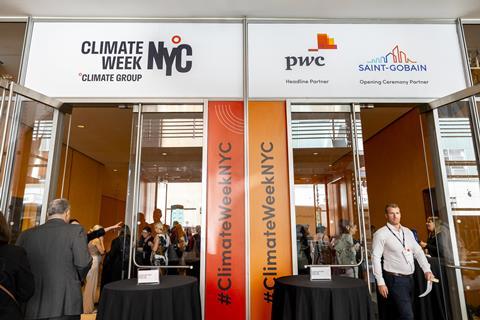Big consultancies back new methods to assess emissions, while Univeristy of Exeter calls for mandates to boost investment in clean technology such as heat pumps

A consistent approach for estimating greenhouse gases in built environment professionals’ designs has been published today as part of New York Climate Week.
The report, backed by big names such Aecom, Arup and WSP, says that designs and advice represent the largest greenhouse gas impact of the environmental and engineering sector. The UN Environment Programme reported that the buildings and construction sector account for .
These emissions are not effectively included in current Science Based Targets because they fall outside the boundaries of the Greenhouse Gas Protocol for Scope 3 emissions.
Published by Pledge to Net Zero, in conjunction with Climate Week NYC, to estimate the greenhouse gas impact of their work, each with different levels of detail and purposes.
David Symons, chair of Pledge to Net Zero and future ready global lead at WSP, said: “It’s excellent to now have some practical guidelines and methods to help our industry estimate the carbon impact of our work. So much of our industry’s work supports climate action, but not all.
“This paper for the first time sets out some practical ways to estimate this, in a similar way that we measure our corporate carbon footprint. It represents real progress and I look forward to seeing our industry’s feedback on this work.”
The three methods for assesment
Fast assessment based on fee
Classify the percentage of fees earned in a year that support, are neutral, or work against a net zero transition. This quick method helps assess corporate alignment with net zero goals and is based on an approach used by the Scottish Government.
Project portfolio estimate based on fee/design activity
Estimate total carbon emissions from a project and allocate these based on the fee or the specific activity being carried out. Advised emissions are allocated by fee percentage, while designed emissions are based on the project element delivered. A representative sample of projects is assessed and extrapolated to provide an annual carbon number. This method is thorough but simple enough for a company wide estimate.
Attribution based on project whole life carbon
Conduct a detailed project assessment and allocate whole-life greenhouse gas emissions across all parties and stages of project delivery based on the extent of influence. It acknowledges that environmental and engineering consultants are not the only influencers, with asset owners, financiers, designers, builders and operators also playing roles. This method is the most thorough and best for estimating carbon emissions of larger projects
Other professional services sectors, such as the legal and advertising sectors, have produced, or are producing guidelines for their advice.
Meanwhile, another report launched at Climate Week NYC has called on governments to start a global cascade of “positive tipping points” to cut prices and carbon emissions by using mandates to switch investment from polluting fossil fuels to clean technologies, such as heat pumps.
Researchers found that regulatory mandates with specific timeframes will ensure clean technologies become cheaper than fossil fuel alternatives up to three years earlier worldwide – reducing carbon emissions in the power, transport and heating sectors by at least 75% in 2050.
The report, called , compares the effectiveness of regulatory mandates, subsidies and carbon taxes in over 70 countries to see which would most quickly lead to positive tipping points in terms of cheaper prices for consumers, enabling clean technologies to outcompete fossil fuels in major emitting sectors.
The mandates the experts assessed and recommend are:
- Require a rising proportion of heating appliance sales to be heat pumps from 2025, reaching 100% by 2035.
- Phase-out of coal power by 2035 for developed countries and by 2045 for developing countries.
- Require a rising proportion of car sales to be zero-emission vehicles, reaching 100% by 2035.
- Require a rising proportion of truck sales to be zero emission vehicles, reaching 100% by 2040.
Co-author Tim Lenton, from the Global Systems Institute at the University of Exeter said: “Mandates are clearly the most effective policy approach – and we call on policymakers worldwide to implement them at speed. Failure to do so will have high human and economic costs.”
Downloads
Estimating the greenhouse gas impact of advice and designs v2
PDF, Size 1.98 mb


























No comments yet